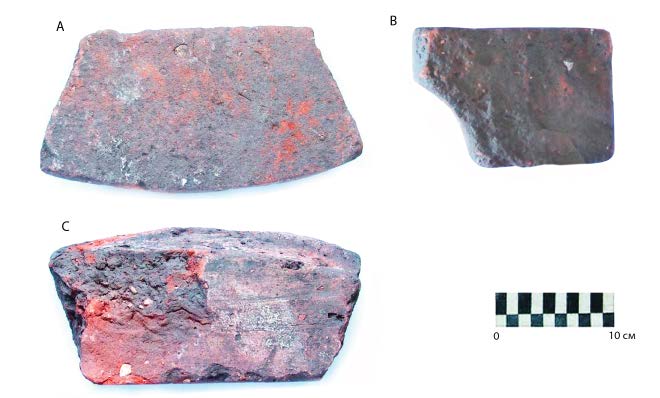GOLDEN HORDE TECHNOLOGIES: BRICKS FROM UKEK
DOI:
https://doi.org/10.24852/2587-6112.2021.3.273.284Keywords:
archaeology, Ukek, Golden Horde, brick, shape, dimensions, elemental composition, thermal and strength characteristicsAbstract
The paper discusses a ceramic bricks from Uvek settlement using the results of fi eld and laboratory studies of 1998–2020. The goal of the research was to defi ne the physico-technical characteristics of bricks from Uvek settlement for historico-architectural, technical and economic substantiation of the construction technologies of the Golden Horde, for reconstruction and restoration work, for computer modeling in virtual and augmented reality systems. The paper presents data on the diverse shapes and dimensions of the bricks, and the imprints on its surface. It discusses the results of studies aimed at establishing the elemental composition of the ceramic material using the Auger method and secondary ion mass spectroscopy (SIMS) to identify the raw material mining sites. Data is provided on the average density of the brick, its group in terms of thermal characteristics, emissivity coeffi cient, water absorption by weight, ultimate compression and bending strength, and its brand in accordance with the parameters regulated by the state standard in effect.
References
Ballod, F. V. 1923. Privolzhskie “Pompei” (The Volga “Pompeii”). Moscow; Petrograd.: “Mospoligraf” Publ. (in Russian).
Bragov, A. M., Lomunov, A. K. 1995. In Prikladnye problemy prochnosti i plastichnosti (The Applied Problems of Strength and Plasticity) 51, 127−137 (in Russian).
Bratashova, S. A. 2016. In Ablyazov, K. A., Kulrin-Gubaidullin, E. A., Rashitov, F. A. (eds.). Istorikoarkheologicheskie pamiatniki Zolotoi Ordy na territorii Saratovskogo Povolzh'ia. Ukek: proshloe, nastoiashhee, budushchee (Historical and Archaeological Monuments of the Golden Horde in the Territory of Saratov Volga Region. Ukek: Past, Present, Future). Saratov: “Nauchnaia kniga” Publ., 211−218 (in Russian).
Vasil’ev, D. V. 2004. In Perekrestki istorii. Aktual'nye problemy istoricheskoy nauki (On the Crossroads of History. Current Issues of Historical Science). Astrakhan: Astrakhan State University, 72–79 (in Russian).
GOST 530-2012. Kirpich i kamen' keramicheskie. Obshchie tekhnicheskie usloviia (GOST 530-2012. Ceramic Brick and Stone. General Specifi cations). Moscow: “Standartinform” Publ. (in Russian).
Gubanov, I. A., Krylova, I. A., Tikhonova, V. L. 1976. Dikorastushchie poleznye rasteniia SSSR (Wild Useful Plants of the USSR). Moscow: “Mysl’” Publ. (in Russian).
Dunaeva, G. V., Rogozin, I. S. 1962. In Opolzni Saratovskogo Povolzh'ia (Landslides of Saratov Volga Region). Moscow: Academy of Sciences of the USSR (in Russian).
Zilivinskaia, E. D. 2016. In Povolzhskaya arkheologiya (Volga River Region Archaeology) 16 (2), 44–67 (in Russian).
Yelshin, D. D. 2010. In Ivakin, G. Yu. (ed.). Arkheologіia і davnia іstorіia Ukraїni (Archaeology and Ancient History of Ukraine) 1. Kiev: Institute of Archaeology of the National Academy of Sciences of Ukraine, 395–407 (in Russian).
Karloson, T. A. 1981. In Fotoelektronnaia i Ozhe-spektroskopiia (Photoelectron and Auger Spectroscopy) Leningrad: “Mashinostroenie” Publ. (in Russian).
Krasnopevtsev, B. V. 2008. In Fotogrammetriia (Photogrammetry). Moscow: "Reprografi ia" Publ. (in Russian).
Krotkov, A. A. 1915. In Trudy Saratovsko uchenoi arhivnoi komissii (Proceedings of the Saratov Scientific Archive Commission). 32. Saratov, 111−130 (in Russian).
Kulpin, E. S. 2001. In Obshchestvennye nauki i sovremennost (Social Sciences and Contemporaneity) 3, 74−88 (in Russian).
Otchet Imperatorskoi Arkhivnoi Komissii za 1891 g. (Report by the Imperial Archival Commission for 1891) Archive of the Institute for the History of Material Culture, Russian Academy of Sciences. F. 10, dossier 30 (in Russian).
Singatulin, R. A. 2006. In Yudin, A. I. (ed.). Arkheologicheskoe nasledie Saratovskogo kraia. (The Archaeological Heritage of the Saratov Region) 7. Saratov: “Nauchnaia kniga” Publ., 76−90 (in Russian).
Singatulin, R. A. 2008. In Yudin, A. I. (ed.). Arkheologicheskoe nasledie Saratovskogo kraia. (The Archaeological Heritage of the Saratov Region) 8. Saratov: “Nauchnaia kniga” Publ., 139−155. (in Russian).
Singatulin, R. A. 2014. In Istoricheskiye, fi losofskiye, politicheskiye i yuridicheskiye nauki, kul'turologiya i iskusstvovedeniye. Voprosy teorii i praktiki (Historical, philosophical and law sciences and study of art. Theory and practice issues) 47 (9) part 1. 149−151 (in Russian).
Singatulin, R. A. 2016. In Izvestiia vysshikh uchebnykh zavedenii. Geodeziia i aehrofotos"emka (Proceedings of Higher Educational Institutions. Geodesy and Aerial Photography) 2. 90−93 (in Russian).
Singatulin, R. A. 2016. In Mezhdunarodnyi nauchno-issledovatel’skii zhurnal (International Research Journal) 7(49), part 1. 105−107 (in Russian).
Singatulin, R. A. 2017. In Sovremennye naukoemkie tekhnologii (Modern High Technology) 8. 65−68 (in Russian).
Fedorov-Davydov, G. A. 1987. Statisticheskie metody v arkheologii: Uchebnoe posobie dlia vuzov po spets. «Istoriia» (Statistical Methods in Archaeology: Study Guide for Universities with Specialization in History). Moscow: “Vysshaia shkola” Publ. (in Russian).
Fedorov-Davydov, G. A. 1994. Zolotoordynskie goroda Povolzh’ia (Golden Horde Towns in the Volga Area). Moscow: Moscow State University (in Russian).
Schulman, A. R., Fridrikhov, S. A. 1977. Vtorichno-ehmissionnye metody issledovaniya tvyordogo tela (Secondary Emission Methods for Solid State Research). Moscow: “Nauka” Publ. (in Russian).
Paparazzo, E. 2001. In. Surface and Interface Analysis 31(12). 1110–1111. DOI:10.1002/sia.1144 (in English).
Paparazzo, E. 2006. In Surface and Interface Analysis (38). 357−363. DOI:10.1002/sia.2142 (in English).

Downloads
Published
How to Cite
Issue
Section
License
Copyright (c) 2021 R.A. Singatulin

This work is licensed under a Creative Commons Attribution-NonCommercial 4.0 International License.







